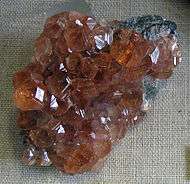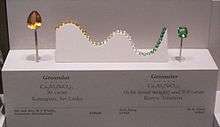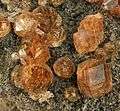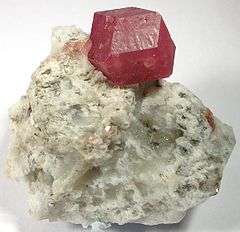Grossular
| Grossular | |
|---|---|
|
Grossular dodecahedron, .7 cm across, from Coahuila, Mexico | |
| General | |
| Category | Nesosilicate |
| Formula (repeating unit) | Ca3Al2(SiO4)3 |
| Strunz classification | 9.AD.25 |
| Crystal system | Cubic[1] |
| Crystal class |
Hexoctahedral (m3m) H-M Symbol: (4/m 3 2/m) |
| Space group | Ia3d |
| Identification | |
| Color | light to dark green, light to dark yellow to reddish brown, occasionally translucent to opaque pink. It is also but rarely found in colorless form[1] |
| Cleavage | none |
| Fracture | conchoidal to uneven[1] |
| Mohs scale hardness | 7 to 7.5[1] |
| Luster | greasy to vitreous[1] |
| Specific gravity | 3.61 (+.15 -.04) |
| Polish luster | vitreous[1] |
| Optical properties | Single refractive, often anomalous double refractive[1] |
| Refractive index | 1.740 (+.12 -.04)[1] |
| Birefringence | none |
| Pleochroism | none |
| Dispersion | .028 |
| Ultraviolet fluorescence | near colorless to light green – inert to weak orange in longwave and weak yellow-orange in shortwave; yellow – inert to weak orange in longwave and shortwave[1] |
| Absorption spectra | Hessonite sometimes shows bands at 407 and 430nm |
| Major varieties | |
| Hessonite | yellow-red to reddish-orange |
| Tsavorite | intense green to yellowish green |
| Leuco-garnet | transparent and colorless[2] |
| Xalostocite | translucent to opaque pink grossularite crystals in marble |
Grossular is a calcium-aluminium species of the garnet group of minerals. It has the chemical formula of Ca3Al2(SiO4)3 but the calcium may, in part, be replaced by ferrous iron and the aluminium by ferric iron. The name grossular is derived from the botanical name for the gooseberry, grossularia, in reference to the green garnet of this composition that is found in Siberia. Other shades include cinnamon brown (cinnamon stone variety), red, and yellow. Grossular is a gemstone.
Grossular should not be called grossularite, grossularite was once a type of rock.[3]
Hessonite


Hessonite or Cinnamon Stone, is a more common variety of grossular with the general formula: Ca3Al2Si3O12. The name comes from the Ancient Greek: ἣσσων (hēssōn), meaning inferior;[4] an allusion to its lower hardness and lower density than most other garnet species varieties.[1]
It has a characteristic red color, inclining to orange or yellow, much like that of zircon. It was shown many years ago, by Sir Arthur Herbert Church, that many gemstones, especially engraved gems (commonly regarded as zircon), were actually hessonite. The difference is readily detected by the specific gravity, that of hessonite being 3.64 to 3.69, while that of zircon is about 4.6. Hessonite has a similar hardness to that of quartz (being about 7 on the mohs scale), while the hardness of most garnet species is nearer 7.5.
Hessonite comes chiefly from Sri Lanka and India[5] where it is found generally in placer deposits, though its occurrence in its native matrix is not unknown. It is also found in Brazil and California.
Deposits
Grossular is found in contact metamorphosed limestones with vesuvianite, diopside, wollastonite and wernerite.
A highly sought after variety of gem garnet is the fine green Grossular garnet from Kenya and Tanzania called tsavorite. This garnet was discovered in the 1960s in the Tsavo area of Kenya, from which the gem takes its name.
Viluite is a variety name of grossular, that is not a recognized mineral species.[6] It is usually olive green though sometimes brownish or reddish, brought about by impurities in the crystal. Viluite is found associated with and is similar in appearance to vesuvianite, and there is confusion in terminology as viluite has long been used as a synonym for wiluite, a sorosilicate of the vesuvianite group. This confusion in nomenclature dates back to James Dwight Dana.[7] It comes from the Vilyuy river area in Siberia.
Grossular is known by many other names, and also some misnomers;[8] colophonite – coarse granules of garnet,[9] ernite, gooseberry-garnet – light green colored and translucent,[10] olyntholite/olytholite, romanzovite, and tellemarkite. Misnomers include[2] South African jade, garnet jade, Transvaal jade, and African jade.
 Color range of grossular graphically displayed at the National Museum of Natural History Washington, D.C.
Color range of grossular graphically displayed at the National Museum of Natural History Washington, D.C. Group of Grossular crystals, largest 1.1 cm, from Asbestos, Quebec
Group of Grossular crystals, largest 1.1 cm, from Asbestos, Quebec
See also
References
- 1 2 3 4 5 6 7 8 9 10 GIA Gem Reference Guide; Gemological Institute of America; 1995; ISBN 0-87311-019-6
- 1 2 Grossular The Mineral and Gemstone Kingdom, accessed online January 25, 2007
- ↑ International Mineralogical Association (1971). "International Mineralogical Association: Commission on new minerals and mineral names" (PDF). Mineralogical Magazine. 38: 102–105. doi:10.1180/minmag.1971.038.293.14.
- ↑
 "Cinnamon-stone". Encyclopædia Britannica. 6 (11th ed.). 1911. p. 376.
"Cinnamon-stone". Encyclopædia Britannica. 6 (11th ed.). 1911. p. 376. - ↑ Note: Hessonite is often called Gomedhaka in Tamil and Sinhalese.
- ↑ Viluite Mindat database
- ↑ The System of Mineralogy of James Dwight Dana. Descriptive Mineralogy By James Dwight Dana, Edward Salisbury Dana, 1892, p. 479-80
- ↑ Grossular Mindat mineral database, accessed January 25, 2007
- ↑ Colophonite The Free Dictionary, accessed online January 25, 2007
- ↑ Gooseberry Garnet WordWeb Online
External links
| Wikimedia Commons has media related to Grossular. |
